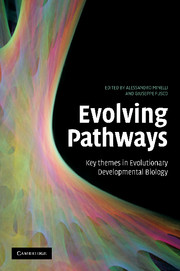Part IV - Evolving body features
Published online by Cambridge University Press: 08 August 2009
Summary
‘Distinctive features’, ‘key apomorphies’, ‘novelties’, ‘innovations’. All these terms point to the fact that some characters in an organism are ‘special’ in some respect, and these have attracted the most interest from biologists and challenged the explanatory capacity of evolutionary theories. These are characters that emerged as new features during the evolution of a lineage, or that are believed to be the principal cause of a successful phyletic radiation. ‘Evolution is tinkering’ and in any such feature there are both new and conserved components, even if it is not always obvious what is new and what is not. By taking development into the picture, can evo-devo provide deeper insight into the origin, evolution and diversification of such characters? The answer seems to be yes.
An initial example is offered by Cassandra Extavour (Chapter 17), who addresses the evolution of bilaterian reproductive systems by examining comparative data on somatic gonad and germ cell specification during development. Surprisingly enough, although reproduction is possibly the most important quality for a living being, the evolution of bilaterian reproductive systems and strategies has received comparably little attention. Was the last common ancestor of bilaterians (the so-called Urbilateria) hermaphroditic? Did it possess a sequestered germ line, or distinctive gonads? The data presented here can tell us what kinds of general features, or basic pattern, Urbilateria's reproductive system was likely to have had, thus accounting for the systems found in extant bilaterian lineages.
- Type
- Chapter
- Information
- Evolving PathwaysKey Themes in Evolutionary Developmental Biology, pp. 317 - 320Publisher: Cambridge University PressPrint publication year: 2008



